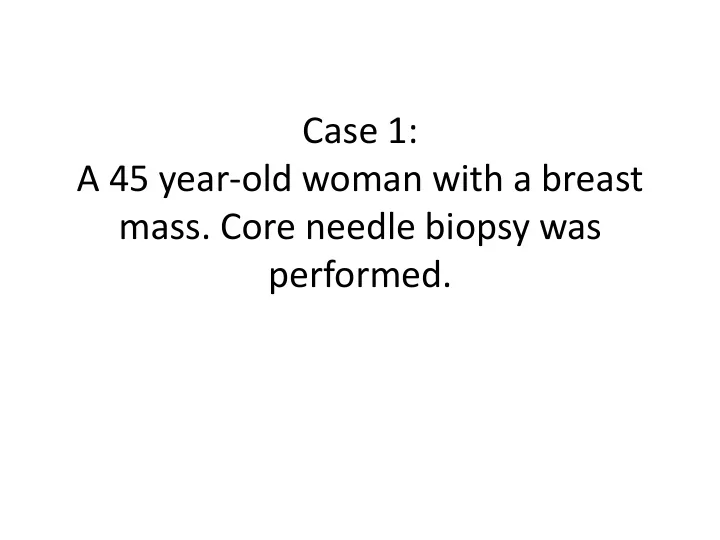

Case 1: A 45 year-old woman with a breast mass. Core needle biopsy was performed.
DIAGNOSIS? ER/PR -
AMGA,excision recommended
Partial mastectomy, periphery of mass
Close to center of mass
Center of mass
Matrix producing ca arising in association with MGA, AMGA and in situ carcinoma Triple negative, Ki-67 10-50%
History of prior excision of a breast mass (8 years earlier) diagnosed as MGA. Slides were requested for review
Prior excision of a breast mass, 8 years earlier.
Review Dx: AMGA, involving margins of resection
Clinical, Histopathologic, and Immunohistochemical Features of Microglandular Adenosis and Transition Into In Situ and Invasive Carcinoma The American Journal of Surgical Pathology. 32(4):544-552, APR 2008 Ibrahim Khalifeh; Constance Albarracin; Leslie Diaz; Fraser Symmans; Mary Edgerton; Rosa Hwang; Nour Sneige
Clinical, Histopathologic, and Immunohistochemical Features of Microglandular Adenosis and Transition Into In Situ and Invasive Carcinoma Khalifeh et al: AJSP 32(4):544-552, APR 2008 • 108 cases (MDACC cases between 1983 -2007 that had a diagnosis of MGA). Of the 108 cases, 65 cases had available material for review. • Eleven out of 65 cases qualified to have an MGA component; remaining 54 cases were classified as adenosis (myoepi. present). • Out of the 11 MGA patients: 3 patients with uncomplicated MGA 2 had AMGA 6 had MGACA.
Microglandular Adenosis and Transition Into In Situ and Invasive Carcinoma Khalifeh et al: AJSP, 32(4):544-552, 2008 Multiple invasive histologic components were identified in each of the MGACA cases. All tumors had strong and diffuse CK8/18 and EGFR expression but no ER/PR, HER2 (ie, triple negative), or CK5/6 expression. C-kit was focally expressed in 2 of the MGACAs. Ki-67 and p53 labeling indices increased with tumor progressions (<3% in all MGAs, 5% to 10% in the AMGAs, and >30% in MGACAs).
Adenosis with infiltrating growth- mimicking MGA Small glands with open lumen distributing randomly. The lining cells have abundant clear cytoplasm and occasional luminal secretions mimicking MGA (A). SMA highlighting the myoepithelial layer in the infiltrative adenosis (B).
Uncomplicated MGA Glands lined by single layer of epithelial cells showing abundant vacuolated cytoplasm and their lumen is open and filled with eosinophilic secretions (A). The glands of MGA strongly express S-100, and SMA confirms the absence of the myoepithelial layer (B).
AMGA MGACA with Packed invasive complex component glands with nuclear hyperchro masia MGACA with in situ component showing expansile glands with obliterated lumens ( C) or severe cytologic atypia with frequent apoptosis and mitosis (D)
Multiple histologic invasive components identified even in the single case: duct- forming (A), clear cell (B), sarcomatoid (C), matrix producing (D), basal-like (E) with bone metastasis (F), aciniclike (G), and adenoid cystic components (H)
A. Diffuse S-100 expression in the whole spectrum from uncomplicated MGA to AMGA ending with MGACA B. Diffuse CK8/18 expression in the uncomplicated MGA and AMGA C. Diffuse EGFR expression in the uncomplicated MGA (upper right corner) and MGACA
A. Ki-67 labeling index in the uncomplicated MGA component (top of the picture), in comparison with AMGA (bottom of the picture) and MGACA (in the right lower corner). B. p53 labeling index in the uncomplicated MGA component (bottom of the picture), in comparison with AMGA (top of the picture) and MGACA (in the right lower corner).
MGA and Transition Into In Situ and Invasive Carcinoma - Khalifeh et al: AJSP, 32(4):544-552, 2008 In a follow-up ranging from 14 days to 8 years: None of the MGA cases recurred. One of the AMGA cases recurred as invasive ca in a background of AMGA after 8 years following incomplete excision of the lesion. Of 6 MGACA cases: 3 (50%) required multiple consecutive resections ending up with mastectomy due to involved margins by invasive or in situ ca.; 2 (34%) developed metastasis and died of disease.
Conclusions • Our data showed that Ki-67 and p53 expression, in conjunction with the morphologic features, could be a reliable marker to distinguish MGA from AMGA and MGACA. • Although 11 tumors were only included in our study, 64% of the tumors were carcinomas arising in MGA. This high incidence of MGACA may not represent the actual frequency of MGAs progressing into carcinoma and is likely due to referral bias in our institution. Nonetheless, the high association of carcinoma with MGA necessitates complete excision of MGA to rule out invasion.
Recommend
More recommend